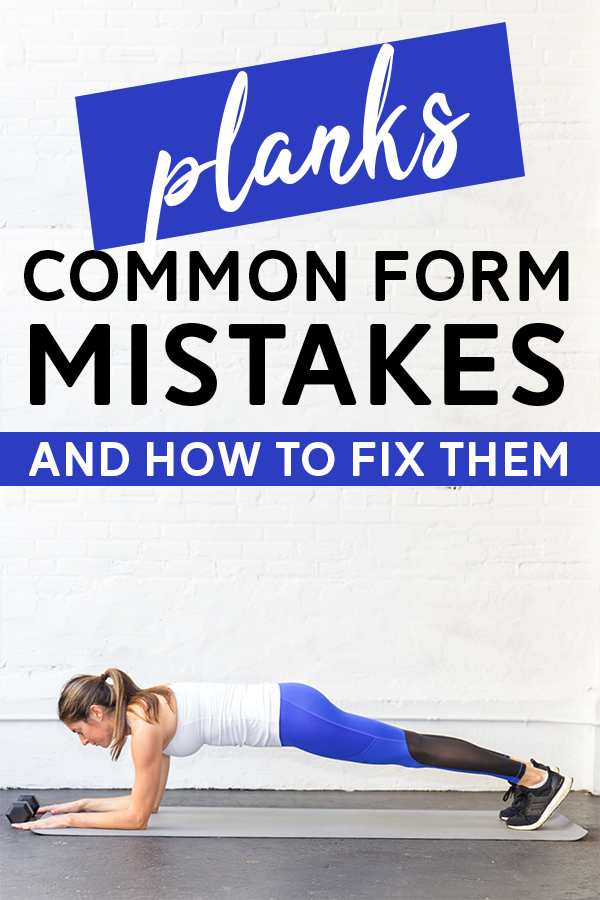
A lot of the core work at Btone (where I teach in Boston) is plank-based, so it’s by far the exercise I see the most. That means that along with the impressive planks, I’ve also seen just about every possible way one could imagine to do them incorrectly. And I don’t mean that condescendingly at all—I used to make a couple form mistakes in plank myself!
Planks seem simple, but like with most exercises, proper form is key for them to be effective. And since countless moves utilize this position in one way or another (push ups, burpees, mountain climbers, etc.), it’s an important one to get right. As a way to explain how to do them correctly, I thought it’d be helpful to go over some of the most common form mistakes in plank I see when teaching.
Common Form Mistakes in Plank

Pelvic Tilt (aka the Booty Pop)

In this error’s defense, it does make you look like you’ve got some killer Kardashian-esque curves. I’M KIDDING. Don’t do this! This postural imbalance is common with a lot of people (not just when planking) because sitting down for long periods of time can cause a tightening of the hip flexors, making us tilt our pelvis and arch the low back. If you look back at some of my original blog posts (back in the days before the PT cert and teaching), you can spot me making this mistake here and there.
Correct It
You want to bring your pelvic bone back to neutral, so from this arched position, you would want to gently tuck the tailbone. I say “gently” because I don’t want you to come into a tucked position, just back to neutral. Think of drawing the low abs up and in, closing some of the space between the hip bones and bottom ribs. Knit the ribs together instead of letting the rib cage fan open.
Over-Engaged Chest
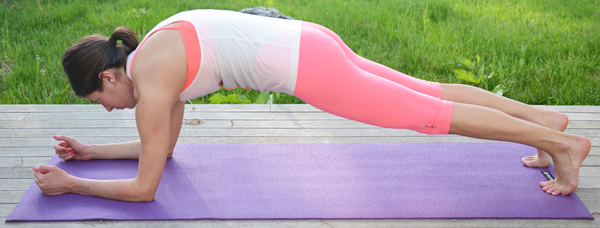
This form error can be spotted by a rounding of the shoulders. It’s very common to have an overdeveloped frontside and a weak posterior body, so oftentimes we’ll overcompensate for a lack of strength in the back and core by propping ourselves up in plank using our chest (and only our chest). If you have a slight hunchback going in your plank, you may be doing this.
Correct It
If you tend to hunch, you may be going into your plank position with rounded shoulders, causing this rounding. Before getting into plank, try rolling your shoulders, opening up the chest, and sliding your shoulder blades down your spine. With this posture, enter the plank position. That way, your posterior (back) is active and not just your chest.
“Heavy” Spine (No Chest Engagement)

It’s hard to demonstrate with pictures while wearing a bra and shirt, but this one is essentially just the opposite of the over-engaged chest. In this form mistake in plank, you’re not engaging your chest at all. As a result, your upper back kind of droops down, spine hanging heavy between shoulder blades that are pinching slightly together. We’re trying to find a neutral upper back position, right in between the over-engaged chest and “heavy” spine.
Correct It
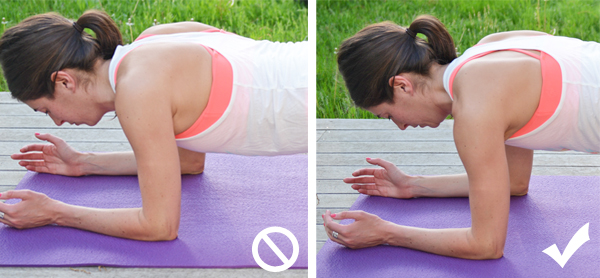
To better demonstrate what’s going on, look at the above picture comparison. It’s a subtle difference, but these pics were taken from the exact same angle. On the left, you can’t see the full racerback of my tank & bra because my back is sunken low in between the shoulder blades (this is incorrect).
To fix it, picture you’re trying to fill the space between your shoulder blades. Engage your chest and press the floor away from you.
Lifted/Piked Hips
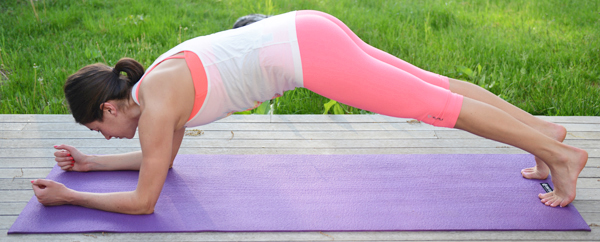
We tend to do this one when we start to tire holding a long plank. Don’t let your body come into this piked, upside-down “v” shape! When we do this, we’re shifting the distribution of our body weight and giving our core a little breather—not the point of the plank exercise.
Correct It
If your butt keeps creeping up into the air like this, think of holding your hips level with shoulder height (probably just below shoulder height if holding a high plank on your hands). From heels to crown of head should be one straight line.
Wrists/Elbows Not Stacked under Shoulders
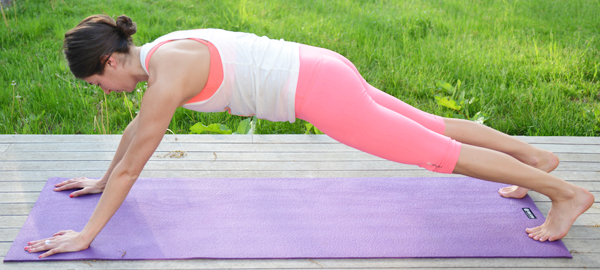

In high plank, I usually see the hands are pressed out a few inches in front of the shoulders. In forearm plank, I most commonly see the opposite, where the shoulders are ahead of the elbows. When you’re in a plank, you want whatever joint is on the ground (wrists if in high plank; elbows if in forearm plank) to be stacked directly underneath your shoulders.
I should note that there is a plank variation where you purposely have your hands on the ground as far in front of your shoulders as possible (“Superman Plank”)—I’m not talking about that. I’m talking about those slight weight redistributions we tend to do as we wiggle our way through a long plank hold.
Correct It
If your elbows are racked under your rib cage, shift your shoulders back. If your hands (or elbows) are out in front of you, shift your shoulders forward.
Under-Engaged Legs

Think of all the ways you start to fidget when you’re holding a plank for a long period of time. Do you ever start to pedal your feet, bending one knee and then the next? Relaxing your knees and having bent legs changes the way our bodyweight is supported in plank.
Correct It
We associate planks with our core, but your legs are working as well! To correct this form mistake in plank, squeeze your quads as if you were trying to lift them off your knee caps. Squeeze your glutes as well.
Heavy Head or Craned Neck

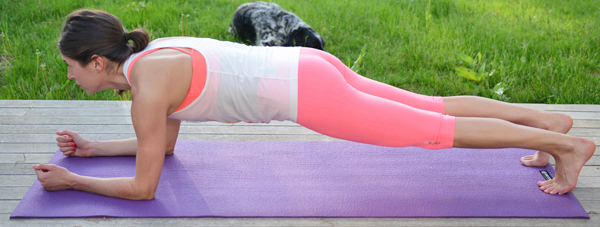
The human head is heavy, but you want to keep a neutral neck. Don’t let your head hang at your chest, but also don’t crane your neck so that your gaze is upward.
Correct It
Setting your gaze right in front of your fingertips usually ensures your neck is neutral. If you’re looking between your legs, your head is hanging too heavy. If you’re looking at yourself in the mirror in front of you, you’re craning the neck.
Planking Workouts
Now that you know the common form mistakes in plank to look out for, let’s practice doing the exercise correctly! I have plenty of plank-based workouts and challenges to try.7
7-Day 4-Minute Plank Tabata Challenge
- (Day 1) High Plank Exercises
- (Day 2) Forearm Plank Exercises
- (Day 3) Forearm + High Plank Exercises
- (Day 4) Slider Plank Exercises
- (Day 5) Full-Body Plank Exercises
- (Day 6) Forearm Slider Exercises
- (Day 7) Sliding High Plank Exercises
Plank Workouts
- Plank Workout
- Incline Plank Challenge Workout (Beginner-Friendly)
- Plank Challenge Workout
Fellow PTs and fitness instructors—any other errors you want to add to this list? And, perhaps more importantly, any cueing tips you want to add for adjusting into correct plank form?
xo Nicole







